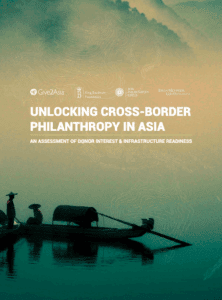An Assessment of Donor Interest & Infrastructure Readiness
This 2022 landmark study, produced by Give2Asia in collaboration with Asia Philanthropy Circle (APC) and King Baudouin Foundation (KBF), provides the first in-depth assessment of the opportunities and barriers to developing cross-border philanthropy within Asia. Covering 15 economies across the region, the report evaluates both donor appetite and infrastructure readiness, offering a roadmap to strengthen Asia-led giving beyond national borders.
The research reveals that while Asia is home to more billionaires than any other continent, cross-border giving within the region remains modest and uneven. Outflows are concentrated in a handful of markets—Australia, Japan, South Korea, China–Hong Kong SAR, and New Zealand—while most others still prioritize domestic needs. Across all markets, donor motivations are heavily shaped by relationships, cultural ties, and alignment with government priorities, rather than tax incentives or transactional ease. 
Regulatory environments remain the single greatest barrier to growth. Many governments impose strict controls on outbound giving, citing concerns over money laundering and terrorism financing, while inconsistent or unclear policies discourage donor participation. Infrastructure gaps also persist, with few intermediaries offering the due diligence, compliance, and advisory services needed to build trust and transparency across borders.
Despite these challenges, the report highlights promising opportunities. Younger philanthropists, diaspora communities, and corporations with regional footprints show rising interest in giving across borders. Education, health, and climate resilience rank among the top causes, with donors increasingly exploring blended models of traditional philanthropy and impact investing.
The report concludes with a readiness index that classifies markets into high, medium, and low levels of preparedness for cross-border giving. It calls for the creation of an Asia-wide giving network to reduce barriers, enhance donor confidence, and unleash the region’s vast philanthropic potential to tackle shared challenges.



